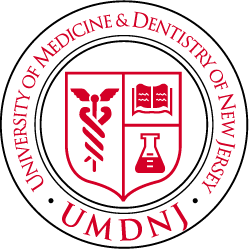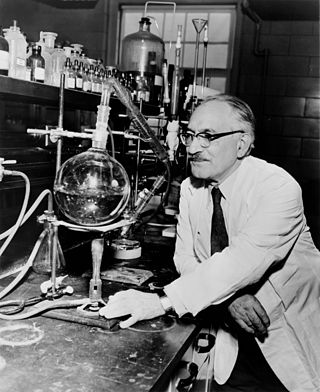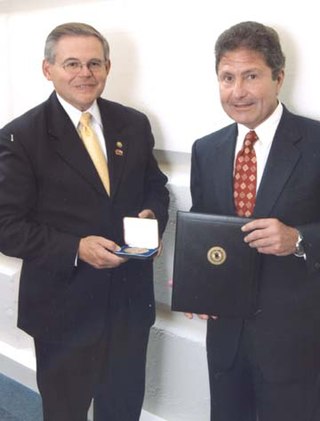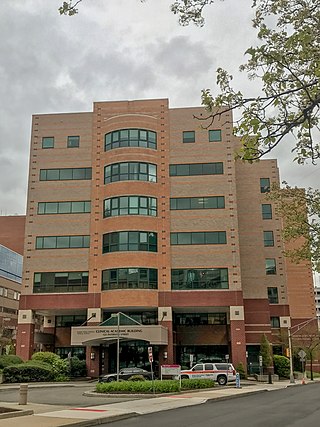
Rutgers University, officially Rutgers, The State University of New Jersey, is a public land-grant research university consisting of four campuses in New Jersey. Chartered in 1766, Rutgers was originally called Queen's College, and was affiliated with the Dutch Reformed Church. It is the eighth-oldest college in the United States, the second-oldest in New Jersey after Princeton University, and one of nine U.S. colonial colleges that were chartered before the American Revolution.

The University of Medicine and Dentistry of New Jersey (UMDNJ) was a state-run health sciences institution of New Jersey, United States.

Selman Abraham Waksman was a Jewish Ukrainian inventor, Nobel Prize laureate, biochemist and microbiologist whose research into the decomposition of organisms that live in soil enabled the discovery of streptomycin and several other antibiotics. A professor of biochemistry and microbiology at Rutgers University for four decades, he discovered several antibiotics, and he introduced procedures that have led to the development of many others. The proceeds earned from the licensing of his patents funded a foundation for microbiological research, which established the Waksman Institute of Microbiology located at the Rutgers University Busch Campus in Piscataway, New Jersey (USA). In 1952, he was awarded the Nobel Prize in Physiology or Medicine for "ingenious, systematic, and successful studies of the soil microbes that led to the discovery of streptomycin." Waksman and his foundation later were sued by Albert Schatz, one of his Ph.D. students and the discoverer of streptomycin, for minimizing Schatz's role in the discovery.

Richard Levis McCormick is a historian, professor and president emeritus of Rutgers University.

Albert Israel Schatz was an American microbiologist and academic who discovered streptomycin, the first antibiotic known to be effective for the treatment of tuberculosis. He graduated from Rutgers University in 1942 with a bachelor's degree in soil microbiology, and received his doctorate from Rutgers in 1945. His PhD research led directly to the discovery of streptomycin.

The School of Environmental and Biological Sciences (SEBS) is a constituent school of Rutgers University's New Brunswick-Piscataway campus. Formerly known as Cook College—which was named for George Hammell Cook, a professor at Rutgers in the 19th Century—it was founded as the Rutgers Scientific School and later College of Agriculture after Rutgers was named New Jersey's land-grant college under the Morrill Act of 1862. Today, unlike the other arts and sciences schools at Rutgers, the School of Environmental and Biological Sciences specializes in environmental science, animal science and other life sciences. Although physically attached to the New Brunswick-Piscataway campus, most of the SEBS campus lies in North Brunswick, New Jersey.

Rutgers Robert Wood Johnson Medical School is a medical school of Rutgers University. It is one of the two graduate medical schools of Rutgers Biomedical and Health Sciences, together with New Jersey Medical School, and is closely aligned with Robert Wood Johnson University Hospital, the medical school's principal affiliate.

Livingston Campus, originally named Kilmer Area by Rutgers University in 1965, and later known as Kilmer Campus, is one of the five sub-campuses of Rutgers University–New Brunswick. The campus was originally built to house Livingston College. The majority of its land is the Rutgers Ecological Preserve. Most of the campus is within the boundaries of Piscataway, but parts extend into Highland Park and Edison.
The Center for Advanced Biotechnology and Medicine (CABM) is located on Busch Campus in Piscataway, New Jersey. It was established in 1985 to advance knowledge in the life sciences for the improvement of human health. It is administered by Rutgers, The State University of New Jersey. The building was completed in 1990, and has 100,000 square feet (10,000 m2) of lab and office space. It now is part of Rutgers Biomedical and Health Sciences campus that was created following the merger of UMDNJ.

The Waksman Institute of Microbiology is a research facility on the Busch Campus of Rutgers University. It is named after Selman Waksman, a student and then faculty member at Rutgers who won the Nobel Prize for Medicine in 1952 for research which led to the discovery of streptomycin. The institute conducts research on microbial molecular genetics, developmental molecular genetics, plant molecular genetics, and structural and computational biology.
New Jersey Medical School (NJMS)—also known as Rutgers New Jersey Medical School—is a medical school of Rutgers University, a public research university in Newark, New Jersey. It has been part of the Rutgers Division of Biomedical and Health Sciences since the 2013 dissolution of the University of Medicine and Dentistry of New Jersey. Founded in 1954, NJMS is the oldest school of medicine in New Jersey.
The Rutgers School of Dental Medicine is the dental school of Rutgers University. It is one of several professional schools that form Rutgers Biomedical and Health Sciences, a division of the university. Established in 1956, the dental school is located in the University Heights neighborhood in city of Newark, New Jersey, United States. It is the only dental school in New Jersey and is one of only two public dental schools in the New York metropolitan area.
The Graduate School of Biomedical Sciences was one of eight schools that formed the University of Medicine and Dentistry of New Jersey (UMDNJ). After the July 1, 2013 dissolution of UMDNJ, the students attending GSBS on the Newark and Piscataway campuses joined the newly created Rutgers University Graduate School of Biomedical Sciences, while the students attending GSBS on the Stratford campus joined the newly established Rowan University Graduate School of Biomedical Sciences.
The Rutgers School of Health Professions is one of the schools that form Rutgers Biomedical and Health Sciences, a division of Rutgers University. The school has campuses in Newark, Piscataway, Scotch Plains, and Stratford, New Jersey. SHP was formerly the School of Health Related Professions of the now-defunct University of Medicine and Dentistry of New Jersey (UMDNJ).
The Rowan-Virtua School of Osteopathic Medicine is a public medical school located in Stratford, in the U.S. state of New Jersey. Founded in 1976, Rowan-Virtua SOM is one of two medical schools associated with Rowan University. Rowan-Virtua SOM confers the Doctor of Osteopathic Medicine degree (DO), and is one of the top medical schools for geriatric care and primary care as ranked by the U.S. News & World Report.

University Hospital is an independent, state owned, teaching hospital in Newark, New Jersey that provides tertiary care to Northern New Jersey. The hospital is certified by the American College of Surgeons and is a state-designated Level 1 Trauma Center, one of only three in New Jersey.

Rutgers University–New Brunswick is one of three regional campuses of Rutgers University, a public land-grant research university consisting of four campuses in New Jersey. It is located in New Brunswick and Piscataway. It is the oldest campus of the university, the others being in Camden and Newark. The campus is composed of several smaller campuses that are large distances away from each other: College Avenue, Busch, Livingston,Cook, and Douglass, the latter two sometimes referred to as "Cook/Douglass", as they are adjacent to each other. Rutgers–New Brunswick also includes several buildings in downtown New Brunswick. It is classified among "R1: Doctoral Universities – Very high research activity". The New Brunswick campuses include 19 undergraduate, graduate, and professional schools. The New Brunswick campus is also known as the birthplace of college football.
Rutgers Biomedical and Health Sciences (RBHS) is the umbrella organization for the schools and assets acquired by Rutgers University after the July 1, 2013 breakup of the former University of Medicine and Dentistry of New Jersey. While its various facilities are spread across several locations statewide, Rutgers Biomedical and Health Sciences is considered the university's fourth campus.

Stanley Silvers Bergen Jr. was an American physician, healthcare educator and administrator, and university president. In 1971, he became the founding president of the incipient College of Medicine and Dentistry of New Jersey which he developed into the University of Medicine and Dentistry of New Jersey (UMDNJ) serving at its helm until his retirement in 1998. While he was president, UMDNJ became the nation's largest public health and science university, home to three medical schools and several allied medical health facilities.












